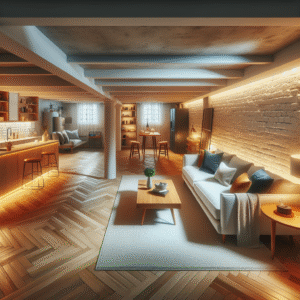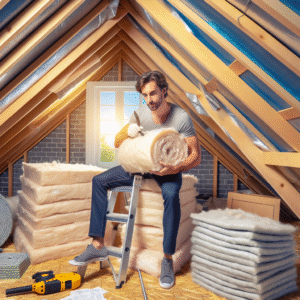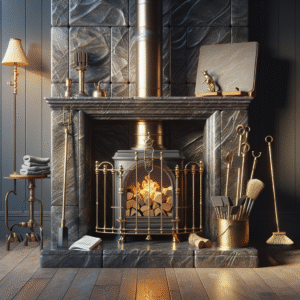Are you looking to enhance your home’s comfort and slash those hefty energy bills? Upgrading your home insulation is a smart move! Effective insulation not only keeps your home warm during the chilly winters and cool in the scorching summers but also significantly reduces energy consumption, leading to lower utility bills. Whether you’re renovating an old house or building a new one, understanding the basics of home insulation and its impact on energy efficiency can make a huge difference. Let’s dive into how choosing the right insulation materials and proper installation can transform your living space into an energy-efficient haven.
Understanding the Basics of Home Insulation and Its Impact on Energy Efficiency
Home insulation acts as a barrier to heat flow, crucial for maintaining a comfortable and energy-efficient home environment. Insulation effectiveness is measured by R-value — higher values mean better insulation and more significant energy savings. Proper insulation not only helps in managing the indoor climate but also reduces the strain on heating and cooling systems, thereby extending their lifespan and enhancing overall home comfort.
Top 5 Insulation Materials for Maximizing Home Energy Savings
- Fiberglass: Widely popular due to its effectiveness and cost-efficiency.
- Cellulose: Made from recycled paper products, ideal for environmentally conscious homeowners.
- Spray Foam: Provides an airtight seal, excellent for preventing air leaks.
- Foam Board: Offers high R-values and is perfect for covering large areas like attic floors and basement walls.
- Reflective Insulation: Best suited for hot climates, it reflects heat away from your home.
Step-by-Step Guide to Upgrading Your Home’s Insulation
Ready to boost your home’s energy efficiency through insulation? Start by assessing your current insulation, identifying areas that need improvement, and choosing the right materials for each part of your home. Here’s a simple guide to get you started:
- Assess Your Current Insulation: Determine the type and thickness of existing insulation to identify energy leaks.
- Choose the Right Materials: Select insulation materials that best suit your climate and home design.
- Hire a Professional: Consider hiring a local expert to ensure proper installation for optimal performance.

If you’re ready to take your home improvement or construction project to the next level, we can help! Find trusted contractors on BuildNet, whether you’re looking for renovations, new builds, electrical work, plumbing, or anything in between. Our directory connects you with qualified professionals who can make your vision a reality.
Understanding the Basics of Home Insulation and Its Impact on Energy Efficiency
Hey there! If you’re looking to enhance the comfort of your home while saving some money on those energy bills, you’ve stumbled upon the right place. Let’s dive into the cozy world of home insulation and uncover how this hidden hero works tirelessly behind your walls to keep your living space energy-efficient and snug all year round. Whether you’re in sunny California or chilling in New York, effective insulation is key to a comfortable home environment.
What Exactly is Home Insulation?
Think of insulation like a warm hug for your house. It’s a material that you install in various parts of your home to help stop the unwanted travel of heat. In the winter, it traps the heat inside, keeping you warm without overworking your heater. Conversely, in the summer, it acts as a barrier to keep the heat out, ensuring your air conditioning doesn’t break a sweat keeping you cool. This not only makes your home more comfortable but also reduces energy consumption and lowers your utility bills.
How Does Insulation Impact Energy Efficiency?
Energy efficiency might sound like a buzzword, but it’s actually pretty straightforward. It’s all about maximizing the performance of your home with the least amount of energy. Here’s how insulation makes that happen:
- Reduces Heat Transfer: Insulation provides resistance to the flow of heat. It’s measured in terms of R-value — the higher the R-value, the better the insulation’s effectiveness. High R-value materials in your attic, walls, and floors keep the desired temperature in your house constant without overburdening your HVAC systems.
- Lowers Energy Costs: By maintaining stable indoor temperatures, insulation reduces the need for heating and cooling, which can significantly lower your energy bills. Some estimates suggest that proper insulation could slash your heating and cooling costs by up to 50%.
- Enhances Comfort: Insulation eliminates drastic temperature fluctuations. By buffering your home against outside temperatures, it creates a more comfortable living environment. No more layering sweaters inside or sweating at your dinner table!
- Reduces Carbon Footprint: By optimizing energy use, insulation helps reduce your home’s carbon footprint. Less energy consumed means fewer carbon emissions, which is a win for the planet.
Identifying the Need for Better Insulation
So, how do you know if your home is under-insulated? Here are a few signs to watch out for:
- Uneven Temperatures: If some rooms are significantly warmer or colder than others, it could be a sign of inadequate insulation.
- High Energy Bills: Compare your energy bills with your neighbors. If yours are noticeably higher, poor insulation could be a culprit.
- Icicles or Ice Dams in Winter: These can form when heat escapes through the roof, melts the snow, and then refreezes at the roof’s edge.
- Chilly Drafts: Noticeable drafts, especially around windows and doors, may indicate poor insulation.
If you’re noticing any of these issues, it might be time to consider an insulation upgrade. Not only will it enhance your comfort, but it will also contribute to a healthier environment inside and outside your home.
Choosing the Right Insulation for Your Home
Selecting the right type of insulation can be a game-changer. The best choice depends on various factors including your climate, home design, and budget. Here’s a quick overview of different types of insulation:
- Fiberglass: Widely used, affordable, and effective. It’s suitable for most areas of your home, especially in attics and walls.
- Spray Foam: Offers excellent air sealing and moisture barrier properties. It’s great for sealing gaps and cracks, providing a comprehensive insulation solution.
- Rigid Foam Board: Perfect for insulating exterior walls, basements, and crawl spaces. It’s also useful for retrofitting old homes without much existing insulation.
- Cellulose: Made from recycled paper products and is environmentally friendly. It’s particularly effective for upgrading wall insulation.
- Reflective or Radiant Barrier: Best suited for hot climates as it reflects heat away from your home, keeping it cooler.
Tips for Homeowners:
When considering insulation materials, always look at the R-value rather than just the material type. An insulation professional can help you determine the appropriate R-values needed for different areas of your home. Remember, the goal is to enhance comfort, save on energy costs, and reduce your environmental impact.
Upgrading your home’s insulation might seem like a daunting task, but it’s an investment that pays off in the long run. Not only does it contribute to a more sustainable planet, but it also makes your home a more delightful place to live. Whether you’re tackling this as a DIY project or hiring a professional, improving your home’s insulation is a smart move towards a more energy-efficient and comfortable home. So, why not start today and feel the difference in every room of your house?

Top 5 Insulation Materials for Maximizing Home Energy Savings
Hey there! If you’re looking to cut down on those energy bills (who isn’t, right?), upgrading your home’s insulation is a savvy move. Not all insulation materials are created equally, so let’s dive into the top 5 materials that are both effective and cost-efficient. This guide will help you make the best choice for your insulation upgrade, ensuring you get the most bang for your buck!
1. Fiberglass Insulation
Fiberglass is the go-to insulation material for many homeowners and contractors alike. It’s made from fine glass fibers and is most commonly found in batts, rolls, and loose-fill forms. Here’s why it’s a favorite:
- Cost-Effectiveness: It’s one of the most affordable insulation materials on the market, making it a great choice for those on a budget.
- High R-value: Fiberglass provides excellent thermal resistance, which means it’s super effective at slowing down the transfer of heat.
- Sound Dampening: In addition to its insulating properties, fiberglass can help reduce noise—a bonus if you live in a noisy neighborhood.
Just a heads-up, though: fiberglass can be irritable to the skin and lungs, so proper protective gear and ventilation are a must during installation.
2. Cellulose Insulation
Made from recycled paper products, primarily newsprint, cellulose is an eco-friendly insulation choice. It’s treated with boric acid, which makes it resistant to fire, mold, and pests. Here’s why cellulose is climbing the ranks:
- Environmentally Friendly: Since it’s made from up to 85% recycled material, it’s a win for your home and the planet.
- Energy Efficiency: Cellulose has a higher R-value per inch than fiberglass, meaning better thermal efficiency.
- Easy Installation: It can be installed using a blowing machine, which is perfect for filling in hard-to-reach areas without dismantling walls.
However, note that while cellulose is cost-effective, it can absorb moisture, so it’s not recommended for areas prone to dampness unless properly treated.
3. Spray Foam Insulation
If you’re looking for something that packs a more powerful punch, spray foam might be your match. There are two main types: open-cell and closed-cell, both offering different benefits:
- Seals Leaks: Spray foam expands to fill gaps, making it excellent for sealing air leaks around windows, doors, and foundations.
- High R-value: Closed-cell foam has a higher R-value per inch than most other insulations, providing superior thermal resistance.
- Moisture Barrier: Particularly with closed-cell foam, it can help prevent moisture problems, which is a bonus in humid climates.
Keep in mind, spray foam is more expensive and must be installed by professionals, but its long-term energy savings can be well worth the investment.
4. Mineral Wool (Rock or Slag Wool)
Mineral wool can refer to either rock wool or slag wool and is made from rock or industrial waste, respectively. It’s known for its durability and excellent fire resistance. Here’s why you might consider it:
- Fire Resistance: It’s non-combustible, which can help contain a fire, adding an extra layer of safety to your home.
- Soundproofing Qualities: Like fiberglass, it’s also effective at sound dampening, making it ideal for noisy areas.
- Thermal Performance: It has a slightly higher R-value compared to fiberglass, providing good insulation against heat transfer.
While mineral wool is more expensive than fiberglass, its robust nature and higher R-value can be a worthwhile trade-off.
5. Rigid Foam Boards
Rigid foam boards are perfect for insulating exterior walls, floors, and roofs. They come in various materials including polystyrene, polyisocyanurate (polyiso), and polyurethane. Here’s why they’re a solid choice:
- High R-value: These boards provide great R-values and are excellent for reducing heat conduction through structural elements like wood and steel studs.
- Versatility: They can be used in a variety of applications, both interior and exterior, including basements and crawl spaces.
- Moisture Resistance: Certain types, like extruded polystyrene, are highly resistant to moisture, which can help prevent mold growth.
Although rigid foam boards are more expensive and require careful installation to avoid gaps, their efficiency in insulating can significantly lower heating and cooling costs.
Choosing the right insulation material can make a significant difference in your home’s energy efficiency and overall comfort. Whether you opt for the affordability of fiberglass, the eco-friendliness of cellulose, the powerful sealing capabilities of spray foam, the robust nature of mineral wool, or the high efficiency of rigid foam boards, you’re taking a step in the right direction towards a more energy-efficient home. Don’t forget to reach out to local experts who can help guide your choice based on your specific needs and regional considerations!
Step-by-Step Guide to Upgrading Your Home’s Insulation
Hey there! Considering an insulation upgrade for your home? It’s a fantastic decision, not only for bolstering your home’s comfort but also for cutting down those pesky energy bills. Let’s walk through the process step-by-step, ensuring you know exactly what to do and how to get the best results. Whether you’re a seasoned DIY enthusiast or thinking about calling in the pros, this guide is your go-to resource for a smoother insulation upgrade.
Step 1: Assess Your Current Insulation
First things first, let’s figure out what you’re working with. Check the attic, walls, and floors. Are there drafts or cold spots in your home? These can be telltale signs that your current insulation isn’t doing its job. If possible, grab an infrared thermometer to check for temperature discrepancies, or consider a more thorough approach like a home energy audit. Local contractors can often perform these audits and give you detailed insights into where your home is losing energy.
Key Points to Check:
- Attic surfaces and flooring
- Wall cavities and external walls
- Basements and crawl spaces
- Areas around windows and doors
Step 2: Choose the Right Insulation Material
Once you know where you need to upgrade, the next step is picking the right material for the job. This choice can depend on several factors like your budget, the specific area you are insulating, and personal preferences regarding sustainability. Materials such as fiberglass, spray foam, or cellulose are popular choices, each with their own pros and cons. For instance, spray foam offers excellent air sealing properties but can be more costly. Your local hardware store or a trusted contractor can help you decide which material suits your needs best.
Step 3: Prepare the Area
Preparation is key to ensuring the insulation will perform effectively. This means cleaning up the areas where you’ll be working—removing any old insulation, dust, and debris. Make sure the spaces are dry and free of mold. Sealing air leaks with caulk or spray foam is a critical step before you add new insulation, especially around windows, doors, and any other gaps.
Step 4: Install the Insulation
Now for the fun part—installation! The process will vary based on the type of insulation you’ve chosen:
Fiberglass Batts:
Cut the batts to fit between joists and studs, ensuring they fill the space without compressing them as this reduces their effectiveness.
Spray Foam:
This is usually a job for professionals, as it involves mixing chemicals and requires special equipment. Spray foam expands to fill spaces, providing excellent air sealing.
Cellulose:
Typically blown in using special machinery, cellulose is perfect for filling in irregular spaces and cavities. It’s also a great choice for environmentally conscious homeowners.
Always wear protective gear such as gloves, masks, and goggles, regardless of the insulation type.
Step 5: Check for Ventilation
Improving insulation can sometimes mean your home is sealed a little too tight. Good ventilation is crucial to prevent moisture issues and ensure air quality. Make sure your attic has adequate venting. This might involve installing new vents or improving existing ones. If you’re unsure, this could be a good time to consult a professional.
Step 6: Review and Test
Once everything’s installed, do another walk-through of your home. Check that everything looks well placed and secure. It might be worth having another energy audit done to compare results and ensure that the insulation is performing as expected. Keep an eye on your energy bills over the next few months as well—you should start seeing the numbers go down!
And there you have it! A step-by-step guide to upgrading your home’s insulation. Remember, taking the time to upgrade your insulation can lead to significant energy savings and a cozier home. Whether you decide to DIY or hire a local expert from a trusted directory like BuildNet, you’re now equipped with the knowledge to make informed decisions. Here’s to a warmer, more efficient home!

What is Home Insulation and How Does It Affect Energy Efficiency?
Home insulation involves the use of materials designed to reduce the heat transfer between the inside and outside of a house. Effective insulation keeps your home warmer in the winter and cooler in the summer, which can significantly decrease energy consumption and lower utility bills. It acts as a barrier to heat loss and gain, particularly in roofs, walls, and floors.
What Are the Top 5 Insulation Materials for Maximizing Home Energy Savings?
- Fiberglass: Widely used due to its effectiveness, affordability, and fire resistance.
- Cellulose: Eco-friendly choice made from recycled paper products, known for its superior air-blocking capabilities.
- Spray Foam: Provides an airtight seal and high R-value, ideal for sealing gaps and cracks.
- Foam Board: Excellent for insulating walls, floors, and ceilings with minimal space intrusion.
- Mineral Wool: Offers soundproofing in addition to thermal insulation, resistant to fire and moisture.
What Are the First Steps in Upgrading Your Home’s Insulation?
The initial step is to assess the current insulation status of your home. An energy audit can help identify areas where insulation is deficient or lacking. Once areas of improvement are identified, you can choose the most appropriate type of insulation material for different parts of your home based on your specific needs and budget.
How Do I Choose the Right Insulation Material for Different Parts of My Home?
Choosing the right insulation material depends on various factors including the climate you live in, your home’s design, and specific needs such as moisture resistance or soundproofing. It’s also important to consider the R-value, which measures the material’s resistance to heat flow. Higher R-values mean greater insulation power.
Can I Install Home Insulation by Myself or Should I Hire a Professional?
While some types of insulation, like certain batts or rigid foam boards, can be a DIY project, others, such as spray foam, should definitely be handled by a professional. Professional installation ensures maximum effectiveness and safety, especially in complex areas like attics or crawl spaces.
What Are the Common Signs That My Home is Under-Insulated?
Some common signs include unusually high heating or cooling bills, uneven temperatures in rooms, cold walls or floors, and issues with ice dams on the roof during winter. If you notice any of these signs, it might be time to consider upgrading your insulation.
Is Upgrading Home Insulation a Cost-Effective Home Improvement?
Yes, upgrading your home insulation is generally considered a cost-effective improvement. It not only reduces energy bills by maintaining a more consistent indoor temperature but also increases the value of your home. The initial investment can often be recouped over time through savings on your energy bills.
How Long Does Home Insulation Last?
Most home insulation materials are designed to last for the life of the building, but this can vary depending on the material type and environmental factors. Regular checks and maintenance can help ensure it remains effective and safe throughout its intended lifespan.
Conclusion
If you’re looking to enhance the comfort and efficiency of your home, upgrading your insulation should be on your to-do list. With various options available, choosing the right insulation material can seem daunting, but it doesn’t have to be. Whether you’re considering fiberglass, cellulose, spray foam, foam board, or mineral wool, each has its advantages depending on your specific needs and the area of your home you’re focusing on.
Remember, proper installation is key to maximizing the effectiveness of home insulation. While DIY can be tempting, for complex projects or materials that require precise installation, hiring a professional is advisable. Interested in getting started but not sure how to proceed? Head over to the BuildNet website and contact a reliable local contractor for a free quote today. Upgrading your home insulation is not only a smart investment for reducing energy bills but also for increasing the comfort and value of your home.







